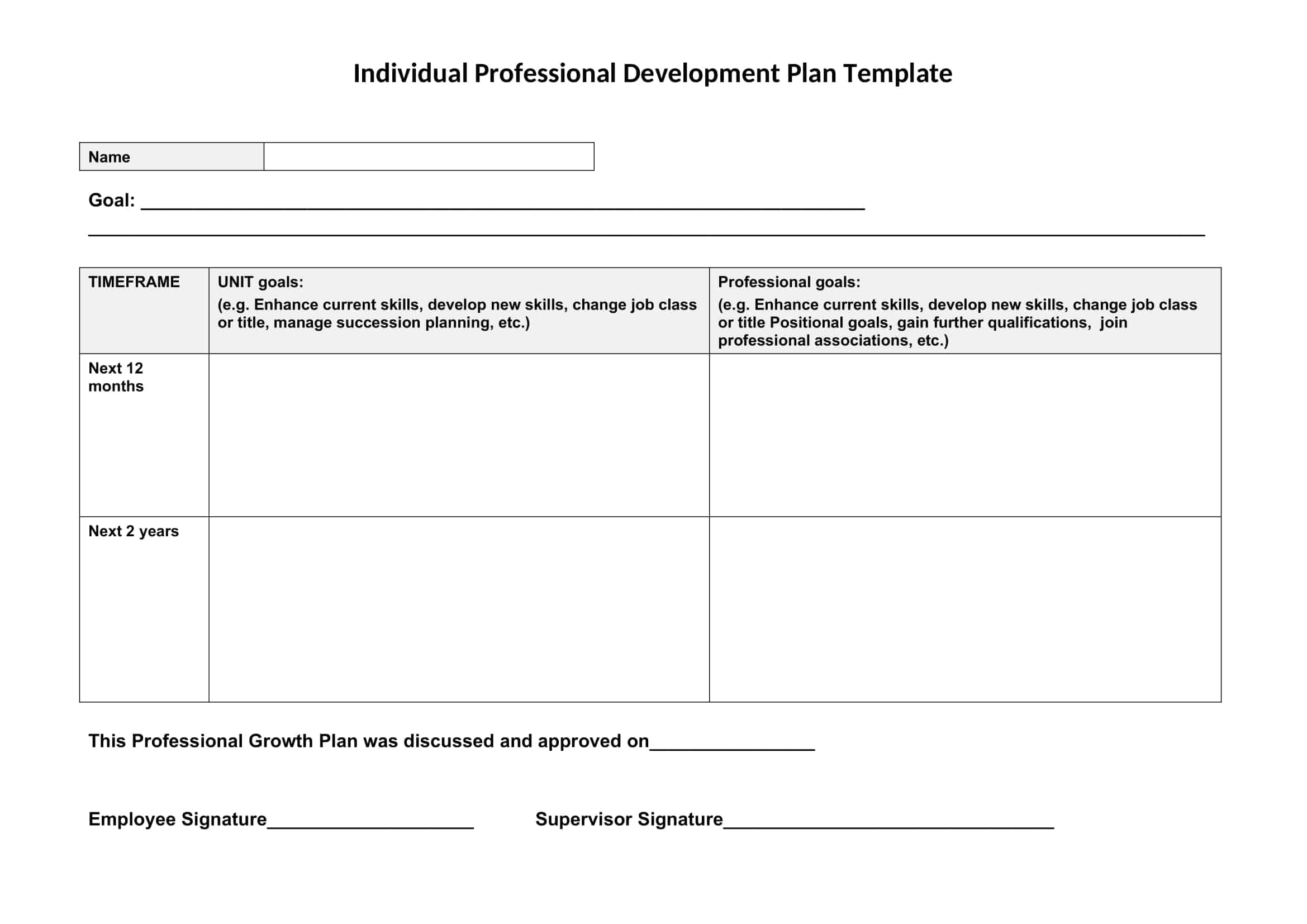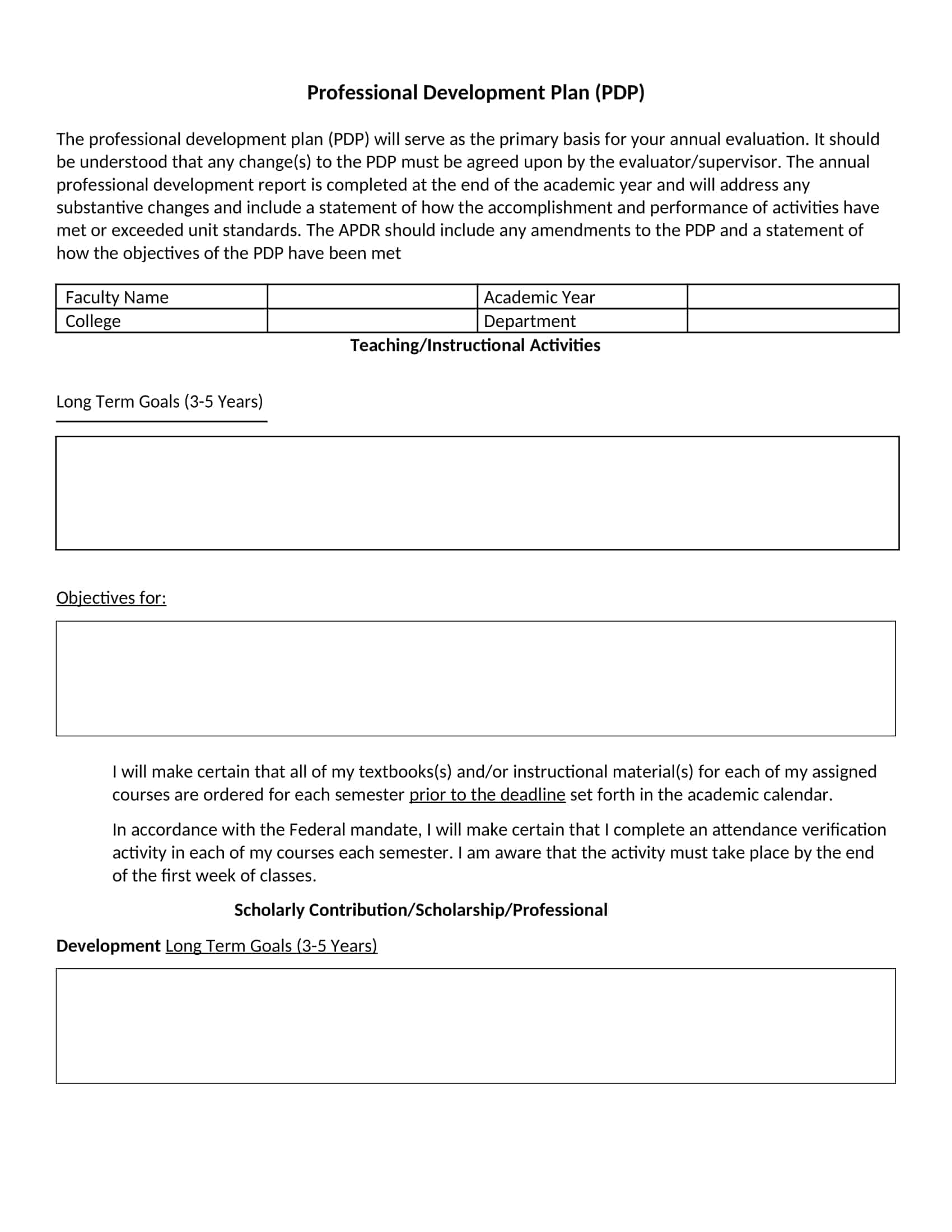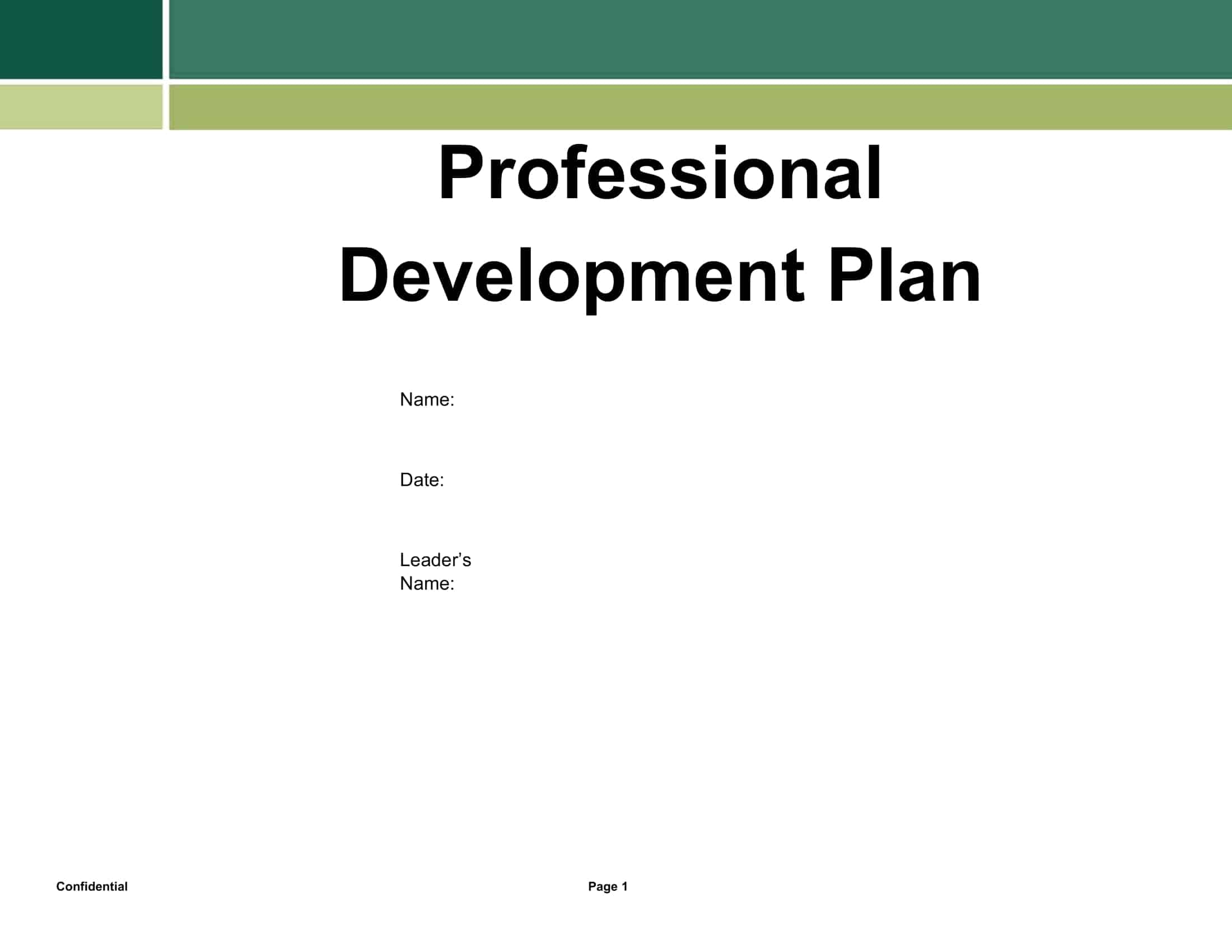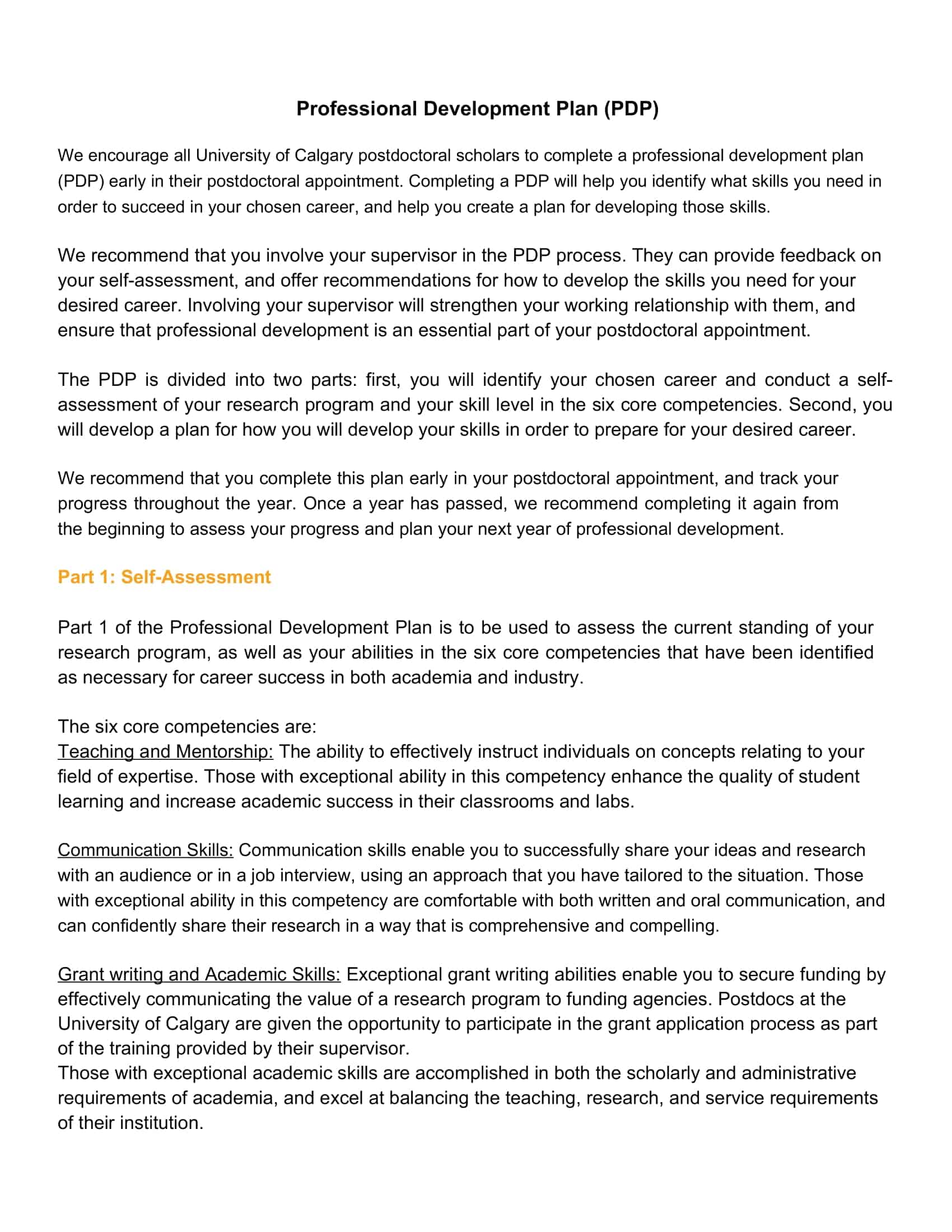To further your career, you may want to consider creating a professional development plan (PDP). A PDP is a document that lists your career goals and strategies on how to achieve them. Creating and executing a PDP may take a lot of time and effort, but it can help you achieve long-term success.
Table of Contents
What is a professional development plan?

A professional development plan (PDP) is a document that outlines your goals and strategies to reach them. This document contains your personal development objectives, ongoing learning activities, and ways to support your efforts.
Because PDPs are structured specifically for each individual, it is recommended that you seek assistance in creating one if you feel unclear about what information should be included or how to go about putting it together properly.
Professional Development Plan Templates
“Professional Development Plan Templates” are pre-designed documents that provide a structured framework for individuals to create personalized plans for their career growth and skill enhancement. These templates serve as valuable tools for professionals who are committed to continuous learning, goal setting, and self-improvement.
A professional development plan is a strategic roadmap that outlines an individual’s goals, objectives, and actions for advancing their career, acquiring new skills, and expanding their knowledge. Professional development plan templates offer a structured layout that helps individuals identify their strengths, areas for improvement, and specific steps to achieve their career aspirations.
By utilizing professional development plan templates, individuals can systematically assess their current skills, identify areas they want to develop, and create a roadmap for achieving their professional goals. These templates guide users in setting SMART (Specific, Measurable, Achievable, Relevant, and Time-bound) goals, identifying relevant learning opportunities, and mapping out the necessary actions and resources needed for growth.
Why do you need a professional development plan?
Career planning brings with it being prepared for life’s surprises. Your roadmap helps you anticipate the risks to be taken, the possible good or bad results, the steps to be overcome step by step, the difficulties that may be encountered, and the opportunities that come suddenly. By evaluating your knowledge, skills, and possibilities, you can plan and take control of your business life.
- It’s beneficial because it helps you to figure out what you want, how to do more of it, and less of what you don’t. It helps determine where you need more skill development based on your career goals and then identifies the steps needed to gain those skills.
- It will help you figure out how to do more of what you want and less of what you don’t, identify skills that still need developing, identify steps toward gaining these skills, or even develop these skills in structured ways through coursework and training, or other experiences.
The characteristics of a people who have a development plan
- Their future expectations are clear.
- They can make the right direction on their career path.
- They work hard to reach the goal.
- They are result-oriented.
- They don’t let failures and obstacles intimidate them.
- They work with a plan.
- They are proactive and forward-thinking.
- They lay the foundations for a decent standard of living for the future.
- They have high imaginations.
- They lay the foundations for the next step.
- They have a perfect chance of reaching their career goals.
- They know very well what they want.
The Most Common Mistakes in Development Plan
- You may be on the rise of your career, and you may feel unhappy. Instead of despairing and giving up, you should try to take your work to a creative level by remembering your effort. ‘
- It may take longer than you expect to rise in your career, or you may find yourself at the top when you least expect it. Giving up out of impatience or fear is among the most common mistakes. It would help if you were patient and not take the opportunities that come with fear.
- You should address your problems with long-term changes instead of short-term solutions. There may be a fundamentally different problem underneath the things that seem to bother you. When you encounter an issue, you should think about the main problem and strive for permanent solutions.
- Your career plan may be interrupted not only by external factors but also by your change. It may change; you may want other things. If you are sure of what you want, you should not hesitate to set new goals where you can also use your old experiences.
How to write a professional development plan?
Preparation of the Development Plan is the Person’s Own Responsibility
Whether you are a manager or an employee, you are primarily responsible for your own development. However, in addition, the manager has responsibilities for the employees’ development plans. For example, while determining the areas that need improvement, the manager should support the determination of the priority ones. Preparation of the development plan is the subordinate’s responsibility. The task of the manager in this regard is to advise, make recommendations and approve the plan for development planning. Another task is to provide resources for plans.
Keep Development Plans Simple and Don’t Make It Long Term!
Managers should support their employees in keeping their development plans simple and short-term because short-term plans work better than long-term plans. “How exactly are you going to do this?” “When do you think you will have finished this?” Such questions are also fundamental in determining the process.
Which Aspect Should You Consider While Preparing Your Development Plan?
When developing development programs, the focus is on strengths rather than weaknesses. However, highlighting the strengths of people and ignoring their weaknesses leaves development incomplete. Therefore, your goal should be first to identify the weaknesses you need and improve them.
What Should You Know When Identifying the Competence You Need to Develop?
The most important competencies required to ensure success in business life; are achievement orientation, communication, and influence. Determine your status in these competencies and, if necessary, add actions towards them at the beginning of your development plan.
At the very beginning of the development process, many people do not know what they need to learn. Do not start your development plan with training if there is no data to prove that you need to develop a specified competency. Your priority should be to define these competencies clearly.
Once you have identified the competency you need to develop, you should learn about your current status in that competency. In this way, you can target where your proficiency in the relevant competence should lead at the end of the training and formulate the behavioral changes you want.
Managers or other people with whom employees interact are also essential resources for development plans. Therefore, it is helpful to ask these people for suggestions for improvement.
If your organization uses a performance appraisal system, you can track its status using feedback. In companies where employee satisfaction surveys are conducted, the survey results will help determine the points that need to be emphasized. If your company has identified all employees’ competencies, you can use this list to create a development plan. You can determine the competencies you need from this list and include those you need to develop into your plan.
How Do You Get the Most Out of Training Programs?
Development plans begin with education. However, training does not mean that you are improving incompetence. But don’t worry. In order for the training you will receive to make the highest contribution to your development; you should pay attention to the following suggestions.
Training where suggestions are exchanged, different problem-solving methods are explored, and the opportunity to compare yourself with others is more helpful for you to improve.
Expand your network by taking advantage of interpersonal interaction opportunities, and aim to increase your self-confidence by communicating abundantly.
Contact the instructor beforehand. Provide a list of your purpose for attending the training and your learning objectives, and get feedback that this training will meet your wishes. In this way, the trainer will try to meet all your goals.
Prepare a summary of the key points of the training you attended or hold a short meeting where you can present them. Thus, you can evaluate the training program and make your development permanent.
Question how you can use what you learned during the training program you will attend in the workplace.
Transfer what you have learned to others in your organization to increase the effectiveness of training. In this way, you can become more active in education and make your investment in education more beneficial.
Educational Programs Are Not Enough for Development!
Training programs can be used for the development of managers and employees. However, these alone are not sufficient for long-term development.
Life itself is a journey of development. The problems we experience in the business world and in daily life enable us to develop as they allow us to look at our inner world constantly. In addition, non-business activities such as social responsibility are essential opportunities to gain leadership skills.
FAQs
What is a Professional Development Plan (PDP)?
A Professional Development Plan (PDP) is a documented record of an individual’s career goals and objectives, along with a strategy and timeline for achieving them. It often includes skill development, education, training programs, and other career-enhancement steps.
Why is a Professional Development Plan important?
A PDP is important because it helps individuals focus on their career goals, identify the necessary steps to achieve those goals, and track their progress over time. It also helps in maintaining a continuous learning attitude, which is essential for career growth.
Who should have a Professional Development Plan?
Anyone interested in advancing their career or developing professionally should consider creating a PDP. It’s particularly useful for individuals at the early stages of their career, those looking to change careers, or anyone aspiring to a leadership position.
Can my employer help with my Professional Development Plan?
Yes, many employers provide support for professional development and may offer resources, funding, or time off for training and education. Discuss your PDP with your supervisor to explore the support available within your organization.
How often should I update my Professional Development Plan?
It’s a good practice to review and update your PDP at least annually or whenever there’s a significant change in your career goals, job role, or personal circumstances.
How do I measure the success of my Professional Development Plan?
Success can be measured by tracking the completion of action steps, achieving the set objectives within the defined timeline, and receiving positive feedback from supervisors, mentors, or peers. Additionally, the attainment of desired career positions or responsibilities can indicate the success of your PDP.
How do I create a Professional Development Plan?
Creating a PDP involves the following steps:
- Reflect on your career goals and what skills or knowledge you need to achieve them.
- Set SMART (Specific, Measurable, Achievable, Relevant, and Time-bound) objectives.
- Identify the resources, training, and experiences necessary to meet those objectives.
- Create a timeline for achieving each objective.
- Get feedback from mentors, supervisors, or peers to refine the plan.
- Document your plan and revisit it regularly to track your progress and make any necessary adjustments.
What are some common components of a Professional Development Plan?
Common components of a PDP include:
- Career objectives
- Skills and knowledge to be acquired or improved
- Action steps and resources required
- Timeline for achieving objectives
- Measures of success
- Reflection and feedback


















































![Free Printable Roommate Agreement Templates [Word, PDF] 1 Roommate Agreement](https://www.typecalendar.com/wp-content/uploads/2023/06/Roommate-Agreement-150x150.jpg)
![Free Printable Credit Card Authorization Form Templates [PDF, Word, Excel] 2 Credit Card Authorization Form](https://www.typecalendar.com/wp-content/uploads/2023/06/Credit-Card-Authorization-Form-150x150.jpg)
![Free Printable Stock Ledger Templates [Excel,PDF, Word] 3 Stock Ledger](https://www.typecalendar.com/wp-content/uploads/2023/08/Stock-Ledger-150x150.jpg)
